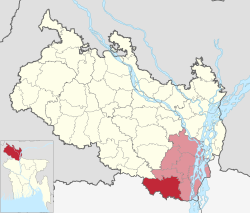Gobindaganj Upazila
This article needs additional citations for verification. (April 2013) |
Gobindaganj Upazila
গোবিন্দগঞ্জ উপজেলা | |
|---|---|
 Mahimaganj Alia Kamil Madrasha, Mahimaganj, Gobindaganj | |
 | |
| Coordinates: 25°8′N 89°23.5′E / 25.133°N 89.3917°E | |
| Country | |
| Division | Rangpur |
| District | Gaibandha |
| Area | |
• Total | 460.42 km2 (177.77 sq mi) |
| Population | |
• Total | 543,144 |
| • Density | 1,200/km2 (3,100/sq mi) |
| Time zone | UTC+6 (BST) |
| Postal code | 5740[2] |
| Area code | 0541[3] |
| Website | gobindaganj |
Gobindaganj (Bengali: গোবিন্দগঞ্জ) is an Upazila of Gaibandha District and the Division of Rangpur.[4] It is one of the largest upazila in Bangladesh including 17 unions and 1 municipality.
Geography
[edit]Gobindaganj is located at 25°08′00″N 89°23′30″E / 25.1333°N 89.3917°E. It has 132,572 households and total area 460.42 km2.
According to the 2011 Census of Bangladesh, Gobindaganj Upazila had 132,572 households and a population of 514,696. Of this population, 119,767 (23.27%) were under 10 years of age. Gobindaganj had a literacy rate of 42.59% (for individuals aged 7 and over), which is lower than the national average of 51.8%. The sex ratio was 1,013 females per 1,000 males. A total of 38,415 (7.46%) people lived in urban areas. The ethnic population was 3,351 (0.65%), with the Santal making up 3,086 of that number.
As per the 1991 Bangladesh Census, Gobindaganj had a population of 414,591. Males constituted 50.89% of the population, while females made up 49.11%. The population of Gobindaganj's rural areas was 205,204. The average literacy rate for this Upazila was 23.1% (for individuals aged 7 and over), compared to the national average of 32.4%.
Administration
[edit]Gobindaganj Upazila is divided into Gobindaganj Municipality and 17 union parishads: Kamdia, Katabari, Shakhahar, Razahar, Sapmara, Darbosta, Taluk Kanupur, Nakai, Harirampur, Rakhalbururz, Fulbari, Gumanigonj, Kamardaha, Kocha Shahar, Shibpur, Mahimaganj, Shalmara. The union parishads are subdivided into 339 mauzas and 375 villages.[5]
Gobindaganj Municipality is subdivided into 9 wards and 22 mahallas.[5]
In terms of total area and number of unions, it is the second largest upazila in Bangladesh. It is called the nucleus of Rangpur Division. It has 13 branches of different banks and 11 colleges as well.
Government
[edit]This section is empty. You can help by adding to it. (March 2025) |
Economy
[edit]1. Small Cottage Industries (Kocha Shahar).
2. Rangpur Sugar Mills Limited (Mahimaganj).
3. Agriculture (Rice & paddy, sugarcane, fisheries, and cattle rearing)
4. Business and others. 5. 001
Education
[edit]According to Banglapedia, Gobindagonj Multilateral High School, founded in 1912, is a notable secondary school.[4]
Literacy rate and educational institutions Average literacy 37.8%; male 42.9%, female 32.5%. Educational institutions: college 13, technical college 1, law college 1, teachers training college 1, secondary school 72, primary school 239, madrasa 153. Noted educational institutions: Gobindaganj Degree College (1965), Kamdia Nurul Haque Degree College (1972), Mahimaganj Degree College (1972), Gobindaganj Mahila College (1991), Nakaihat College, Mahimaganj Women College, Phulpukuria College, Shamim & Shakil Technical College, Akramul Haque Computer and ideal College, Shohorgachhi Adarsa Degree College, Gobindaganj Multilateral High School (1912), Kamdia Bilateral High School (1921), Gobindaganj BM Girls' High School (1940), Rangpur Sugar Mills High School (1962), Birat High School (1964), Shahargachhi Girls' High School (1971), Mahimaganj Alia Madrasa (1937), Mahimagonj high School (1945), Chandpara Alim Madrasa (1963), Chandpara Bi-Lateral High School (1965), Kocha Shahar Bi-Lateral High School (1962), Kocha Shahar Shilpanagori College o Goveshona Kendra (2002).
References
[edit]- ^ National Report (PDF). Population and Housing Census 2022. Vol. 1. Dhaka: Bangladesh Bureau of Statistics. November 2023. p. 403. ISBN 978-9844752016.
- ^ "Bangladesh Postal Code". Dhaka: Bangladesh Postal Department under the Department of Posts and Telecommunications of the Ministry of Posts, Telecommunications and Information Technology of the People's Republic of Bangladesh. 21 October 2024.
- ^ "Bangladesh Area Code". China: Chahaoba.com. 18 October 2024.
- ^ a b Nandi, Bishnu (2012). "Gobindaganj Upazila". In Islam, Sirajul; Jamal, Ahmed A. (eds.). Banglapedia: National Encyclopedia of Bangladesh (Second ed.). Asiatic Society of Bangladesh.
- ^ a b "Bangladesh Population and Housing Census 2011 Zila Report – Gaibandha" (PDF). bbs.gov.bd. Bangladesh Bureau of Statistics.

